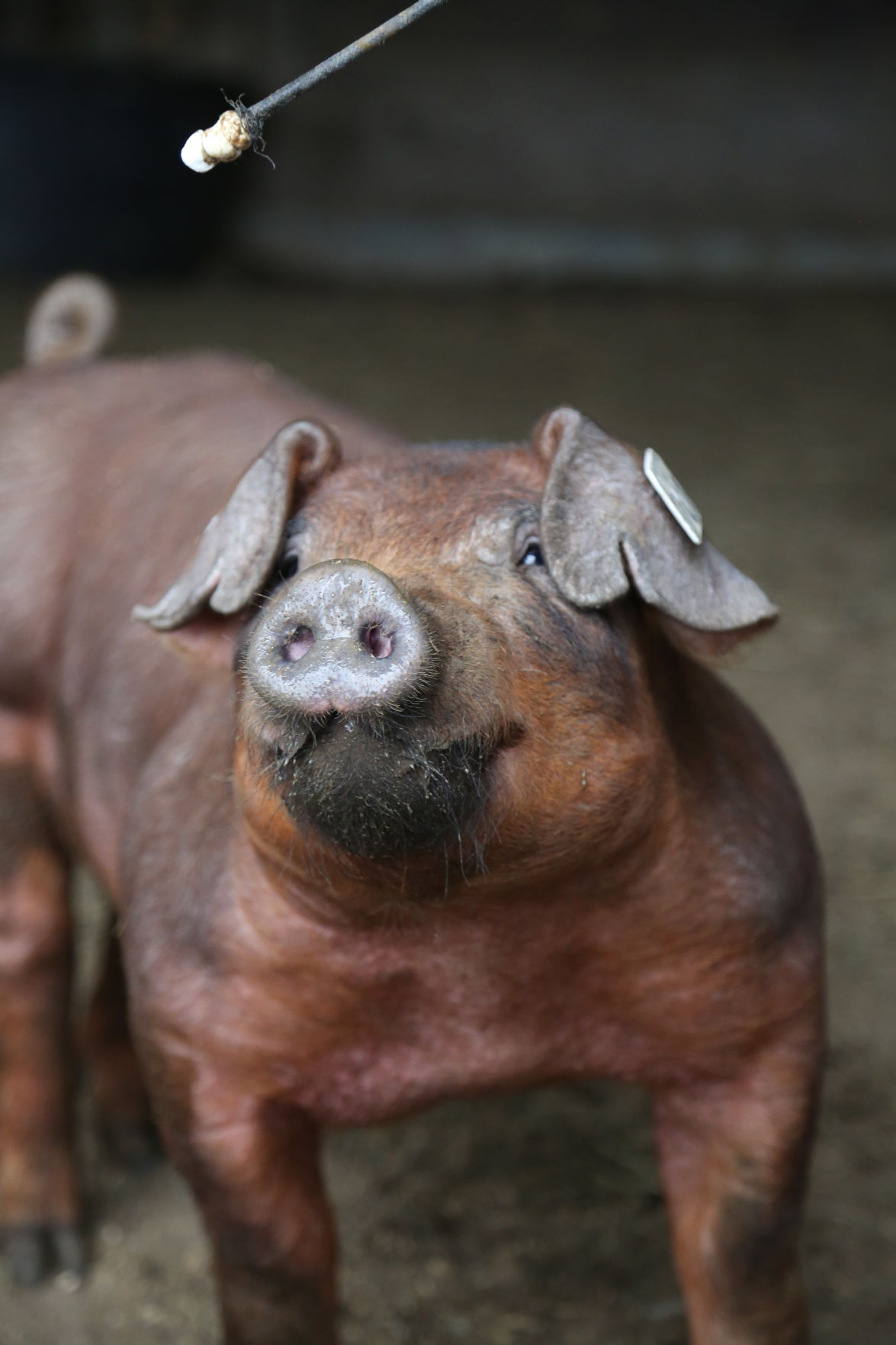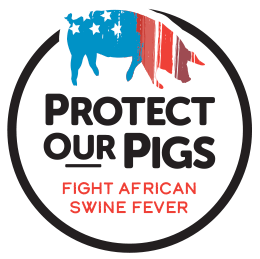Recent cases of African swine fever have been spreading through China, Mongolia and Vietnam, as well as locations in the European Union. Although the United States has never had a case of ASF, animal health officials are taking precautions to remain free of the disease here.
According to U.S. Department of Agriculture’s Animal and Plant Health Inspection Service, ASF is a highly contagious and deadly viral disease that affects both wild and domestic swine of all ages. It poses no threat to human health and cannot be transmitted from pigs to humans. Pork remains safe to eat.
Recently, Pam Zaabel, veterinary specialist with the Center for Food Security and Public Health at Iowa State University, recently led a discussion about how the Secure Pork Supply plan fits into the response to ASF. She’s led the effort to raise animal disease awareness and provide educational materials to veterinarians and livestock producers.
The SPS plan has three components—biosecurity, traceability and surveillance.
The control and eradication strategy for domestic swine in the U.S. includes a “stamping out” approach, she said.
“It will involve the population of clinically affected swine and animals that are considered to be exposed to the virus,” Zaabel said.
The USDA APHIS plan describes quarantine and movement control for infected farms.
“And that control area movement will occur only by permit based on the risk of that movement,” she said. “The Secure Pork Supply plan is working to support swine premises that are affected by those movement controls, but not infected with African swine fever.”
Zaabel said as the first case of ASF is diagnosed, no new animal movements will be initiated or allowed. However, when and if this happens, there could possibly be animals already on the road in transport.
“So what happens to all these animals in transit? Moving either to slaughter or to the next stage of production?” Zaabel said. “We get that question frequently from producers.”
If that were to happen, all the animals would have to land somewhere in order for control areas to be established as the extent of the outbreak is being determined. Animal health officials and others making these decisions are trying to determine the protocol if this were to happen.
“But it seems that a lot of the discussion may be leaning towards allowing the animals to continue to their destination,” Zaabel said.
Producers might have to just sit tight and understand they might not be able to move animals for a period of time.
“After a few days, animal movements, may be allowed to resume,” she said. “This is where the Secure Pork Supply plan enters the picture.”
Movement will only be allowed to resume and permits issued after biosecurity measures have been implemented and surveillance protocols followed.
“When issuing movement permits animal health officials will need to balance the risk of permitting live animal movement, and possibly spreading the disease with the animals needing to be euthanized if they’re not permitted to move off of the site,” Zaabel said.
Secure pork
The goal of the SPS plan is to support business continuity for pork premises that are affected by movement controls, but not infected with ASF. The SPS plan also includes protocols for foot and mouth disease and classical swine fever.
Sign up for HPJ Insights
Our weekly newsletter delivers the latest news straight to your inbox including breaking news, our exclusive columns and much more.
“During an actual outbreak, decisions will be made by the animal health authorities based on the unique characteristics of each outbreak,” Zaabel said.
Participation in the SPS plan is voluntary and funded by USDA and the Pork Checkoff. Zaabel said there’s a number of resources available on www.securepork.org that can help producers protect herds from ASF.
One of the most vital components of the plan, biosecurity, starts with producers.
“It is important for them to protect their herd, by keeping the disease off the farm,” Zaabel said. “Of course, it is the responsibility of the animal health official to protect the U.S. herd in the effort to try to keep the disease from spreading.”
It’s recommended farms have a biosecurity manager, a written site specific biosecurity plan, have a defined perimeter buffer area on their farm and have a defined line of separation.
“The biosecurity manager needs to have an understanding of infectious diseases, production animal agriculture, and be familiar with a facility,” Zaabel said. “He or she will use a self assessment checklist, have an information manual and biosecurity templates to write the site specific biosecurity plan.”
Employees will need to be trained in biosecurity, with the biosecurity manager making sure appropriate training takes place. She said this individual should be someone on site who could monitor for compliance.
“They could be an owner, a site manager, a veterinarian or even an employee on the site,” Zaabel said. “If the system, for example, has one biosecurity manager for multiple sites within that system, then an onsite manager is responsible for ensuring the best security.”
The site biosecurity plan needs to explain how the plan is implemented or will be implemented with biosecurity measures given in their checklist. This has to include a site map with parking, defining the perimeter buffer area and the separation of it all.
“At this time, we’re not stipulating that all the biosecurity measures included in the plan need to be in place prior to an outbreak. The plan just needs to specify how they will be implemented and in the event of an outbreak,” Zaabel said. “Then we encourage them to move forward with implementing those measures that they can implement prior to the outbreak.”
The essential component for improving enhanced biosecurity is to implement the barrier—which separates dirty or potential sources of infection from clean areas.
“We call that the line of separation or LOS,” Zaabel said. “When we’re talking about animals that are housed indoors, the walls of the building make up the LOS.”
The purpose of the LOS is to prevent movement of the virus into the building.
“Or this is where additional animals could be exposed,” she said.
Traceability
The second aspect of the SPS plan is being able to trace animal movement. Zaabel said there’s been a lot of talk about premise identification, and many producers already have their PIN. This can help animal health officials locate the premises with 911 addresses, GPS coordinates and latitude/longitude numbers of the actual location of the animal.
“It’s important to have that validated PIN as it will speed up communication response during an outbreak,” Zaabel said. “Another good way to start preparing is to start associating that PIN with your animal movement records and diagnostic laboratory conditions, and there are some producers that are currently doing that.”
She said producers can make sure they’re recording animal movements by maintaining good records. These include: having a visitor log book and tracking other movements on the site—such as visitors and equipment. Keeping those records electronically is ideal, but paper copies are acceptable too.
“The records can be a combination of paper records such as a visitor log book, and electronic records such as animal movement records,” Zaabel said. “We work with the National Pork Board to update some forms that were already being used in PQA Plus to include the PQA Plus logo the SDS logo.”
There’s also a questionnaire available on the SPS plan website about foreign animal disease exposure. This should give producers a feel for whether or not they’re tracking the right information if an outbreak occurs.
“We asked them if they’re looking for signs and keeping certain records and that sort of thing in their practice questionnaire,” Zaabel said. “It’s not meant to replace the heavy questionnaire during an animal disease outbreak.”
Surveillance
If the farm is in a regulatory control area, surveillance may include periodic inspections by animal health officials or the herd veterinarian. Caretakers can help with this process by looking for its production parameters and clinical signs associated with ASF and the overall health of the animals in the herd.
“Animal caretakers, they do look over their animals on a daily basis and they can review the clinical signs associated with ASF,” Zaabel said. “So if they observe these signs, they do need to know who to contact immediately.”
Zaabel and those with the SPS plan encourage a line of communication between caretakers and animal health officials so they know proper protocols, and most importantly, who to call first. There are ASF wall charts, videos and other materials available on the website. Materials are available in English and Spanish.
“The wall chart is laminated, and so it can be in the barn for animal caretakers to see and be reminded of what clinical signs and production parameters to watch for,” she said. “They can be downloaded as a PDF off the website or they can be ordered free of charge to producers if they order them from the Pork Store.”
Surveillance may include both testing and observation.
“Depending on the size of the outbreak, samples may need to be collected and tested,” Zaabel said. “Veterinarians may need to observe animals prior to loading to ensure that there’s no clinical sign or evidence. They may have somebody again on the site, that are documenting.”
Caretakers trained to look for clinical signs of disease should be on site looking for those signs, observing introduction parameters and recording these items on a daily basis.
“Their documented reporting will be valuable to the animal health officials with an outbreak,” Zaabel said.
Sampling protocols haven’t been established yet for ASF testing from the SPS plan perspective.
“I think it’s beneficial for all producers or caretakers under the guidance of their veterinarian to help collect their own samples,” she said.
The SPS plan does have information on sample collection and has been working with animal health officials to develop the right documents for collection.
For more information about the plan visit www.securepork.org. For more information about African swine fever visit www.aphis.usda.gov/aphis/ourfocus/animalhealth/animal-disease-information/swine-disease-information/african-swine-fever.
Kylene Scott can be reached at 620-227-1804 or [email protected].



